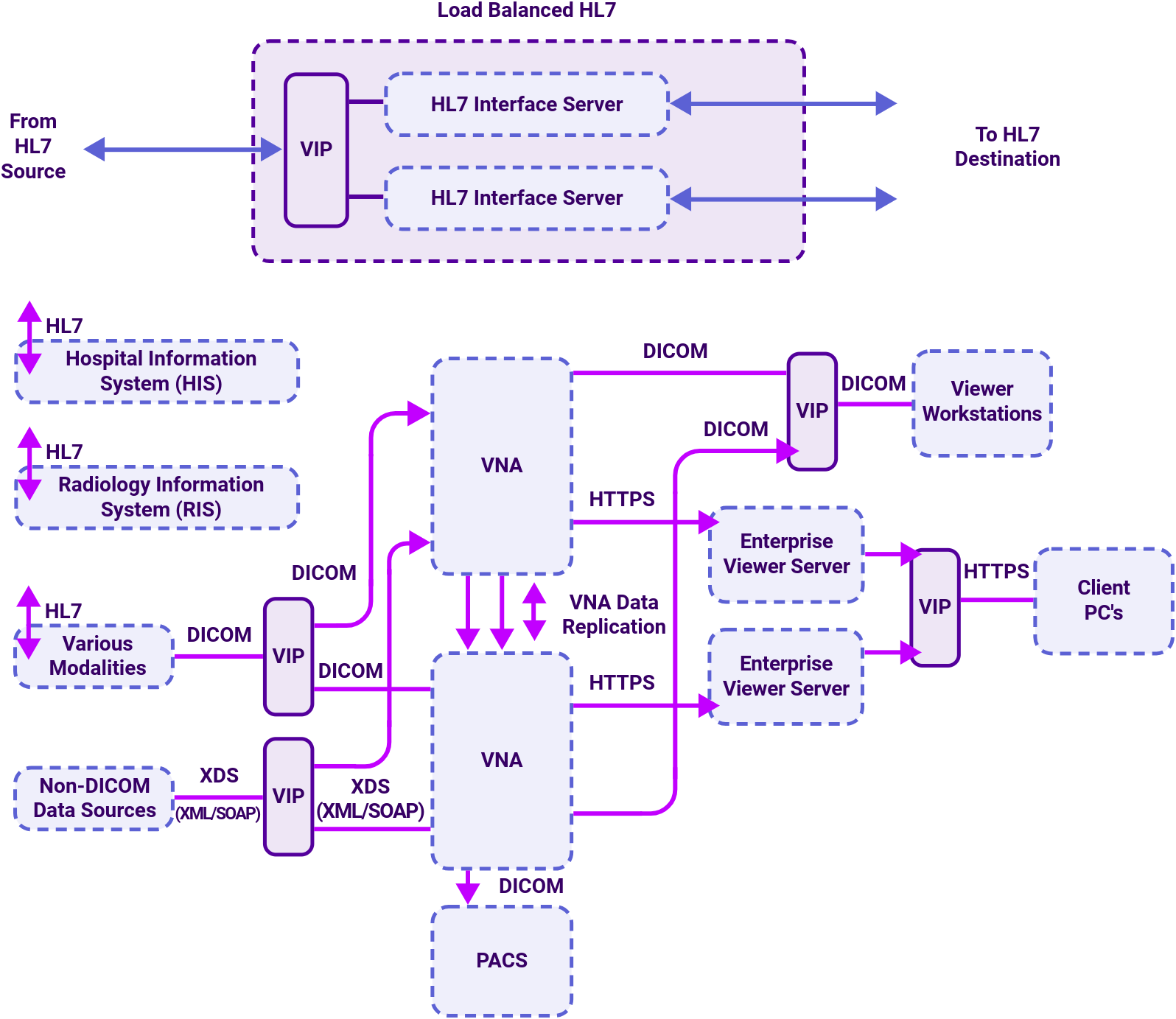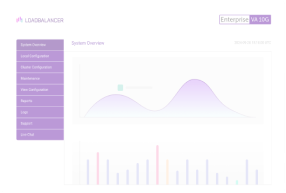Load balancing Medical imaging systems: PACS, VNA, DICOM, XDS and HL7
Benefits of load balancing medical imaging systems
The top three benefits of load balancing in medical imaging systems are High Availability, enhanced performance, and scalability:
- High Availability (HA): Load balancing is critical for achieving near-zero downtime, which is essential in a 24/7 patient care environment where timely image access can be life-saving. A load balancer monitors the “health” of all image servers (e.g., PACS or Vendor Neutral Archive/VNA servers). If one server fails, the load balancer automatically and seamlessly redirects all new and existing traffic (DICOM studies, image retrieval requests) to the remaining healthy servers. This prevents any one server failure from causing an outage and ensures continuous, uninterrupted access to critical diagnostic images and patient data for clinicians and radiologists.
- Enhanced performance: Medical imaging files (like those from CT, MRI, and 3D mammography) are very large, which can easily overwhelm a single server. Load balancing addresses this by distributing the processing load. It intelligently routes incoming requests to the server that is least busy or has the most available resources, preventing any single server from becoming a bottleneck. This distribution ensures rapid processing and retrieval of large imaging studies, leading to faster response times for clinicians, which directly improves the workflow and reduces turnaround times for reports.
- Scalability for future growth: Load balancing provides the flexibility needed to handle the constantly increasing volume of medical data and growing user demands without service interruption. As your organization grows or acquires new, high-volume imaging equipment, you can easily add new servers to the PACS or VNA cluster. The load balancer automatically incorporates these new servers into the distribution pool, allowing the system to scale out its capacity and handle the increased workload without taking the system offline or degrading performance.
About Load balancing medical imaging systems
Medical imaging provides a non-invasive procedure of taking images with a clinical application, using a variety of imaging modalities to provide a specified diagnostic picture of the body. Various modalities are used, such as CT, MRI, PET, Ultrasound and X-Ray.
A critical element in patient care, access to diagnostic images is crucial at all times, especially when demand is unpredictable. Load balancing provides a fast, redundant and scalable architecture for the transfer, storage and retrieval of images.
Why Loadbalancer.org for medical imaging systems?
Loadbalancer.org are the preferred and validated solution for leading PACS systems globally and work closely with industry-leading medical imaging vendors and healthcare organizations, where our solution is easily deployed.
For more than 20 years, we have worked with a range of ‘blue chip’ customers and partners such as Fujifilm, Philips, GE Healthcare, Change Healthcare, Carestream, and Hologic, and developed validated solutions for many others.
Our extensive experience engineering healthcare applications (from Enterprise Imaging to Clinical Workflows, EHR to Interoperability solutions) allows us to work closely with existing and prospective customers to develop solutions that facilitate high availability, scalability, and zero downtime for critical healthcare applications.
How to load balance medical imaging systems
Failures can be costly to the healthcare system and to patients, so achieving zero downtime is a key consideration. Loadbalancer.org appliances monitor the status of medical imaging storage and applications servers (health checks) and seamlessly directs traffic to the healthy, online or least loaded servers.
Here is an example of a highly available system that utilizes system component and load balancing:

A typical load balancing implementation
A standard imaging deployment combines fast, highly available storage with unrestricted retrieval of images using our ultra-fast Layer 4 Direct Routing (DR) mode of operation. In a large hospital environment, peak image retrieval traffic volumes can be more than 5x the volume of storage traffic. The example outlined here demonstrates the benefits of DR and why our products are so well suited to medical imaging requirements.
| Imaging | Total images | MB/Image | MB/study (RAW) | Number of studies/year | Storage per study type (MB) |
|---|---|---|---|---|---|
| Cardiology imaging device | 22 | 22.11 | 486.42 | 10,000 | 4,864,200 |
| CT – Multi-slice imaging device | 400 | 0.52 | 208.00 | 20,000 | 4,160,000 |
| CT – 64-slice imaging device | 2000 | 0.51 | 1020.00 | 100,000 | 100,000,000 |
| CT – 128-slice imaging device | 4000 | 0.51 | 2040.00 | 200,000 | 200,000,000 |
| Fluoroscopy imaging device | 24 | 1.96 | 47.04 | 50,000 | 2,352,000 |
| Mammography imaging device | 4 | 26.00 | 104.00 | 20,000 | 2,080,000 |
| MRI – Magnetic resonance imaging device | 400 | 0.18 | 72.00 | 10,000 | 720,000 |
| Ultrasound imaging device | 40 | 0.75 | 30.00 | 30,000 | 900,000 |
| Total | 440,000 | 315,076,200 |
In this example of 440k studies/year we have a yearly storage requirement of 315TB, which equates to 863GB per day, or a data rate of 1.9GB/s. The below table demonstrates how the retrieval traffic exceeds 11GB/s but, by utilizing DR mode, traffic on the return path bypasses the load balancer directly to the client, meaning there is no packet flow limitation. In practice, this means our entry-level hardware provides reliable image retrieval on a deployment of this size.
| Number of stations | Studies/hour | Study size MB (avg) | Data rate Mbit/s | |
|---|---|---|---|---|
| Reporting stations traffic | 45 | 100 | 1020 | 10,200 |
| Concurrent users traffic | 1000 | 10 | 30 | 667 |
| CDR PACS users | 600 | 40 | 60 | 533 |
| Total traffic | 11,400 |
Below are examples of the systems, standards and protocols that support load balancing:
| Protocol | Description |
|---|---|
| PACS | Picture Archiving and Communication System (PACS) provides storage and access to diagnostic images from multiple modalities. |
| VNA | Vendor Neutral Archive (VNA) is an archival system, capable of storing images in a standard format. |
| DICOM | Digital Imaging and Communications in Medicine (DICOM) is a standard for storing and transmitting medical images. |
| HL7 | Health Level-7 (HL7) is a set of standards for transfer of data between software applications used in healthcare. |
| XDS | Cross-Enterprise Document Sharing (XDS) is a standard for sharing of patient Electronic Healthcare Records. |
Load balanced ports and services
The following tables shows the typical ports/services that are load balanced:
| Port | Protocols | Use |
|---|---|---|
| 104 | TCP/DICOM | Exchange of images and related information |
| 11112 | TCP/DICOM | Exchange of images and related information |
| 2575 | TCP/HL7/MLLP | Communication between healthcare IT systems |
| 443 | TCP/HTTPS | Client viewer connectivity |
| 17035 | TCP/XDS/SOAP/XML | XDS repository/registry |
Loadbalancer.org specializes in load balancing healthcare applications and is the only vendor with native support. In order to support such an array of different applications, we use a variety of load balancing methods including Layer 4 DR, Layer 4 NAT and Layer 7 SNAT modes.
Experts in load balancing medical imaging applications
You need a vendor who’s experienced in supporting the healthcare industry to the highest standards and who has worked with some of the world’s leading medical imaging vendors. Loadbalancer.org is committed to understanding your business, and partnering with you to meet your goals. Our team of application delivery specialists will help design and simplify your architecture, as well as providing round-the-clock support.
Vendors we’ve worked closely with
Formal endorsement of our products should not be denoted from the third party logos cited above. For further details refer to the ‘Disclaimer and Fair Use Statement’ in our Terms & Conditions.






















